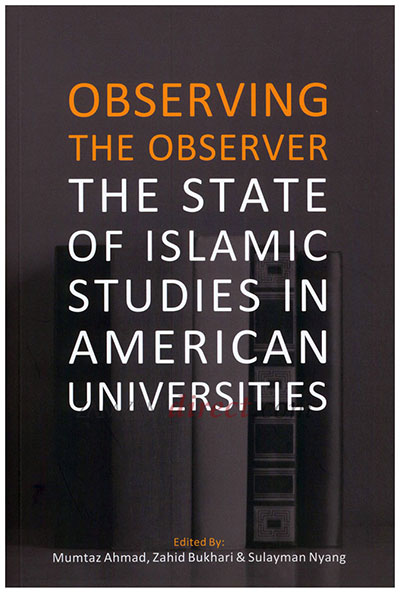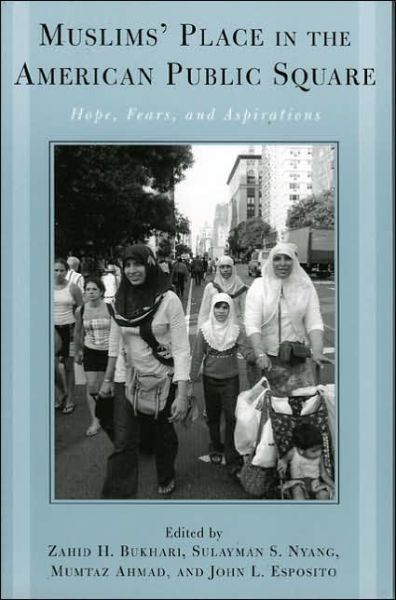Developing a “Just and Balanced Society Index (JABSI)” on the Basis of Maqasid Al-Sharia
By Zahid Bukhari, Ph.D.
Oct 3
Posted by editor in Religion & Development | Comments off
Developing a “Just and Balanced Society Index (JABSI)” on the Basis of Maqasid Al-Sharia
By Zahid Bukhari, Ph.D.
Oct 3
Posted by editor in Muslims in America, Religion & Development | Comments off
Testimony Before a Joint Hearing of the House Financial Services Subcommittee on Oversight and Investigations and the House International Relations Subcommittee on International Terrorism and Non proliferation
May 4, 2005, 2:00 PM, 2128 Rayburn House Building
Hearing entitled: “Significance of Zakah in Islam and Charitable traditions of Muslims in America”
Dr. Zahid H. Bukhari
Director, American Muslim Studies Program (AMSP), Fellow, Center for Muslim-Christian Understanding, School of Foreign Service, Georgetown University
Read the rest of this entry »
Oct 3
Posted by editor in Publications | Comments off
 Book: Observing the Observer: The State of Islamic Studies in American Universities
Book: Observing the Observer: The State of Islamic Studies in American Universities
by Ed. Mumtaz Ahmad (Author) , Ed. Zahid Bukhari (Author) , Ed. Sulayman Nyang (Author) , Mumtaz Ahmad (Editor) , Zahid H. Bukhari (Editor) , Sulayman S. Nyang (Editor) , Shiraz Khan (Editor)
The collection of papers in this volume documents the study of Islam in American Universities. Over the last few decades the United States has seen significant growth in the study of Islam and Islamic societies in institutions of higher learning fueled primarily by events including economic relations of the U.S. with Muslim countries, migration of Muslims into the country, conversion of Americans to Islam, U.S. interests in Arab oil resources, involvement of Muslims in the American public square, and the tragic events of 9/11. Although there is increasing recognition that the study of Islam and the role of Muslims is strategically essential in a climate of global integration, multiculturalism, and political turmoil, nevertheless, the state of Islamic Studies in America is far from satisfactory. The issue needs to be addressed, particularly as the need for intelligent debate and understanding is continuously stifled by what some have termed an Islam industry run primarily by fly-by journalists, think tank pundits, and cut-and-paste experts.
Hardcover $23.48
Paperback $16.34
Product Details
Paperback: 292 pages
Publisher: International Institute of Islamic Thought (IIIT); 1st edition (July 1, 2012)
Language: English
ISBN-10: 1565645804
ISBN-13: 978-1565645806
Product Dimensions: 8.8 x 5.9 x 0.9 inches
Shipping Weight: 1 pounds
Average Customer Review: Be the first to review this item
Amazon Best Sellers Rank: #1,359,680 in Books
Oct 3
Posted by editor in News & Events | Comments off
The American Muslim Studies Program (AMSP) at the Prince Alwaleed Bin Talal Center for Muslim-Christian Understanding (ACMCU), Georgetown University, cordially invites you to attend:
A One-Day Conference on The American Mosque in the 21st Century
Georgetown University — Copley Lounge 37th & O St., NW – Washington, DC 20057
Thursday, February 19, 2009 — 09:00 AM – 05:00 PM
Since the early twentieth century, the Muslim communities in the USA have been establishing mosques in various parts of the country. With the passage of time, these mosques have assumed new functions and roles. They have been transformed from a place of worship to community centers, to schools, and finally to forums for Muslims’ involvement in public policy issues. They have also become the backbone of the fundraising drives of the American Muslims for local and international projects. In a post 9/11 era, however, the mosques and Islamic centers have received extra attention, and sometime scrutiny, from the law enforcement agencies, media personnel and policy makers. The question is how these mosques and Islamic centers can be equipped to face the new challenges and demands of the 21st century? A group of academics, architects and religious scholars will address these issues.
Full program:
http://www.cippusa.com/wp-content/uploads/2013/10/Mosque-Conference-Program-1.pdf
Oct 3
Posted by editor in Muslims in America | Comments off
Conversation with Leadership
March 20, 2008 – 10:00 AM – 4:30 PM – Room ICC-270
POINTS TO PONDER
These points are not intended to be complete or comprehensive, nor are they in any order of significance. They are only intended to stimulate thinking and discussion.
Mosque and Muslim Identity – at the individual level
Mosque and Muslim Communal Presence – at group level
Mosque and Governance – by-laws, leadership and conflict resolution
Mosque and Worship – congregational prayers and rituals
Mosque and Social Cohesion – counseling, bonding, social service
Mosque as Sacred Space – centrality of prayer area and facilities
Mosque and Aesthetics – architecture, functionality, space design
Mosque as Center of Learning – khutbahs, halaqas, schools, education at all levels
Mosque and Change – persuasion and education by Imam and leadership
Mosque and Relations with other Mosques – especially between suburban & inner-city
Mosque and Mobilizations – advocacy for social and political causes
Mosque and Society – symbolism, activism, representation
Read the rest of this entry »
 Book: By Zahid H. Bukhari (Editor), Sulayman S. Nyang (Editor), Mumtaz Ahmad (Editor), John L. Esposito (Editor), Taha Jaber Alalwani (Contribution by).
Book: By Zahid H. Bukhari (Editor), Sulayman S. Nyang (Editor), Mumtaz Ahmad (Editor), John L. Esposito (Editor), Taha Jaber Alalwani (Contribution by).
Overview
Once a year Muslims from around the world—representing a vast range of ethnicities, incomes, ages, and attitudes—perform the Hajj (pilgrimage) and converge in the holy city of Mecca in Saudi Arabia. Now, the global diversity of Muslims at the Hajj is almost repliacted in the United States: new immigrants, Muslims whose families have been here for generations, and converts are coming together, seeing what unites them and what issues they face together. Project MAPS (Muslims in the American Public Square) began in 1999 to provide much-needed information on this understudied and immensely diverse group of six million Americans. This first volume emerging from the project, Muslims’ Place in the American Public Square, shows where the American Muslim community fits into the American religious and civic landscape both before and after 9/11. Renowned scholars contribute theoretical, legal, historical, and sociological perspectives on how Muslims function in both their own institutions and others. For classes in religion or the social sciences, or for anyone interested in this increasingly significant community, Muslims’ Place in the American Public Square provides a current, balanced introduction.
Read the rest of this entry »
An interview with Zahid H.Bukhari, Director of the American Muslim Studies program at the Georgetown University, by Rita Rudusa.
You have conducted a study of Muslims living in the US[1]. What were your key findings about the distinctive characteristics of an average American Muslim?
During the Project MAPS we came up with five characteristics of the American Muslim community. But before describing them, I would like to say, briefly, that nobody knows the exact number of American Muslims, because this question is not asked in census. There are different estimates — some say there are about six million, in 1989, The New York Times published that figure. Some scholars contest it and think there are three million. Interestingly, Hollywood also mentioned American Muslims. In the movie Syriana one of the characters says that there are ten million. So, we are between three and ten million (laughs). However, there is consensus among scholars that numbers are growing.
Read the rest of this entry »
Oct 2
Posted by editor in Muslims in America, Religion & Development | Comments off
The United States Census Bureau produces quality data about almost all aspects of the nation’s people and the economy. One can find in its annual reports personal data on class, race, ethnicity, gender, age, education, profession, occupation, income level, marital status, place of birth and origin of immigrant country. Besides the details of households’ facilities, the census reports also include data on Americans’ agricultural and industrial activities and resources. However, it is quite astonishing that the information on the religion of the American people is totally absent from the national census. These socio-economic variables are especially important in understanding the human behavior. While we question most of these variables, the “R” question is conspicuously absent. Several other developed countries including England, Canada and Australia, on the other hand, include the religion question in their censuses.
Read the rest of this entry »
Oct 2
Posted by editor in Muslims in America | Comments off
Washington DC, the capital of the United States, is also called a city of strangers. Each election cycle brings several thousands newcomers, elected and nominated, to this city. They make policy decisions about the future of the nation during their tenure and then at the beginning of the new cycle the majority of them decide to stay in the city permanently.
The DC diamond, surrounded by a circular road, the Beltway, has its own unique attraction. Every politician of the country dreams about joining the DC circle. However, during the election process the candidates campaign on the slogan that he or she doesn’t have any connection to Washington. While the media pundits around the nation always talk about ‘who controls this city’ and ‘how it works?’
Professor Sulayman Nyang of Howard University describes Washington as a city of twelve tribes who have their own sub-cultures, maintain and developed their own streets, restaurants, languages, abbreviations, etiquettes and sets of agenda. These tribes and their off springs could be explained as follows:
Read the rest of this entry »
Oct 2
Posted by editor in Muslims in America | Comments off
The Pew Research Center has issued an interesting study of Muslim Americans on May 22 and it was reported widely in the American media. The thrust of the Pew study, “Muslim American: Middle Class and mostly Mainstream” is that Muslim Americans are “decidedly American in their outlook, values and attitudes.” It is, however, shocking that several media outlets and political pundits projected Pew’s overall positive picture of the American Muslim community in a very negative and biased way.
Three issues from the Pew study have become the focus of media reporting and discussion: support of suicidal bombing and al-Qaida among youth under 30 and African American Muslims; Muslim’s belief that the Arabs were not responsible for the 9/11 attack; and the low count of Muslim Americans (2.35 million). The wildly different interpretations of some of the Pew study results remind me of the classical story of the ‘blind men and the elephant’ when the blind men tried to explain the elephant by touching one part and then describing it with their own perspectives or prejudices.
Read the rest of this entry »
You are currently browsing the archives for October, 2013
Arclite theme by digitalnature | powered by WordPress